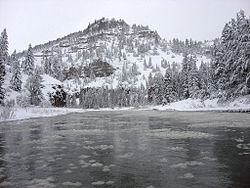Smith River (Montana)
| Smith River | |
|---|---|
 | |
 | |
| Physical characteristics | |
| Mouth | |
• elevation | 3,330 feet (1,010 m)[1] |
| Basin features | |
| River system | Missouri River |
Smith River is a tributary of the Missouri River, in central Montana, in the United States. It rises in southern Meagher County in the Castle Mountains and flows northwest in the valley between the Big Belt and Little Belt mountains, past White Sulphur Springs and past Smith River State Park. It turns north-northwest (NNW), and is joined by Hound Creek in Cascade County, and joins the Missouri approximately 9 miles (14 km) southwest of Great Falls.
The Smith is a Class I river from the Camp Baker Fishing Access site near Ft. Logan to its confluence with the Missouri River for public access for recreational purposes.[2]
Noted for its spectacular scenery and blue-ribbon trout fishery, the Smith River is unique in that it has only one public put-in and one public take-out for the entire 59-mile (95 km) segment of river. Boat camps located along the remote river canyon help preserve the unique quality of this area. The Smith River between Camp Baker and Eden Bridge is the only river corridor managed by Montana Fish, Wildlife & Parks as a permitted river. Permits for private floats on the Smith River are allocated to the public via a lottery system prior to the spring season. Permit applications are typically available the first week of January each year, with an application deadline of mid-February.[3]
The Smith River is currently threatened by a large copper mine that is proposed to be built directly adjacent to and underneath its most important tributary, Sheep Creek. [4][5]
See also
Notes
- ^ a b c "Smith River". Geographic Names Information System. United States Geological Survey, United States Department of the Interior.
- ^ Stream Access in Montana
- ^ http://fwp.mt.gov/recreation/activities/smithRiver/default.html
- ^ http://www.saveoursmith.com
- ^ http://www.nytimes.com/2015/07/19/travel/can-montanas-smith-river-survive-a-nearby-mine.html?_r=0
External links
 Media related to Smith River (Montana) at Wikimedia Commons
Media related to Smith River (Montana) at Wikimedia Commons
